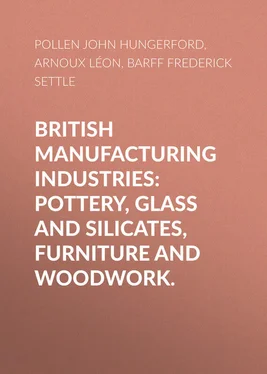John Pollen - British Manufacturing Industries - Pottery, Glass and Silicates, Furniture and Woodwork.
Здесь есть возможность читать онлайн «John Pollen - British Manufacturing Industries - Pottery, Glass and Silicates, Furniture and Woodwork.» — ознакомительный отрывок электронной книги совершенно бесплатно, а после прочтения отрывка купить полную версию. В некоторых случаях можно слушать аудио, скачать через торрент в формате fb2 и присутствует краткое содержание. ISBN: , Жанр: foreign_antique, foreign_prose, на английском языке. Описание произведения, (предисловие) а так же отзывы посетителей доступны на портале библиотеки ЛибКат.
- Название:British Manufacturing Industries: Pottery, Glass and Silicates, Furniture and Woodwork.
- Автор:
- Жанр:
- Год:неизвестен
- ISBN:http://www.gutenberg.org/ebooks/38953
- Рейтинг книги:5 / 5. Голосов: 1
-
Избранное:Добавить в избранное
- Отзывы:
-
Ваша оценка:
- 100
- 1
- 2
- 3
- 4
- 5
British Manufacturing Industries: Pottery, Glass and Silicates, Furniture and Woodwork.: краткое содержание, описание и аннотация
Предлагаем к чтению аннотацию, описание, краткое содержание или предисловие (зависит от того, что написал сам автор книги «British Manufacturing Industries: Pottery, Glass and Silicates, Furniture and Woodwork.»). Если вы не нашли необходимую информацию о книге — напишите в комментариях, мы постараемся отыскать её.
British Manufacturing Industries: Pottery, Glass and Silicates, Furniture and Woodwork. — читать онлайн ознакомительный отрывок
Ниже представлен текст книги, разбитый по страницам. Система сохранения места последней прочитанной страницы, позволяет с удобством читать онлайн бесплатно книгу «British Manufacturing Industries: Pottery, Glass and Silicates, Furniture and Woodwork.», без необходимости каждый раз заново искать на чём Вы остановились. Поставьте закладку, и сможете в любой момент перейти на страницу, на которой закончили чтение.
Интервал:
Закладка:
Previous to glazing, the printed ware must be brought to a red heat, for the sole object of burning the oil mixed with the colour. This is done in kilns, called hardening-on kilns .
The colours in use for printing under the glaze are not many; as few only of the preparations made with metallic oxides can, when brought to a red heat, stand the action of the glazes under which they are laid. Most of them in this case will be dissolved and considerably weakened, if they do not even completely disappear. Cobalt, and the preparations made from chromates, are the most resisting, and, when well prepared, the glaze in melting over them will bring out the colour with increased beauty.
The necessity for covering the biscuit with glaze to stop the absorption of liquids or greasy substances, which would find their way into its interior and would stain it, is so obvious, that I do not think it necessary to dwell on the importance of this operation. I have stated already that it was used by the Egyptians and Assyrians, who knew most of the saline mixtures by which white and coloured glazes could be obtained; but these, which for the greatest part were alkaline silicates, could not have resisted the action of time as they have done, if a certain amount of silicate of lead had not made them permanent. They found this material in the sulphide of lead, which by the silica it contains, or that which it meets on the body of the ware, gives a glaze, which stands exposure to damp better than any other. That this mineral was used in remote antiquity, proofs are numerous. I recollect, amongst others, some small shalti, or sepulchral figures, made in Egypt more than two thousand years ago, of which the red parts, such as the faces and hands, have been glazed in this way. My opinion is, that it was used by the Greeks, in connection with the black oxide of iron, to produce the black colour used in the decoration of their vases, and it might some day prove that it was an indispensable material in the preparation of the red smear, which is the characteristic feature of the Samian ware. At all events it is with this single material, stained with metallic oxides, that the Arabs glazed their rich-looking pottery, and the same was used afterwards for our encaustic tiles and our common pottery, from the time of Elizabeth down to the middle of the last century. Lately, however, the science of making glazes has considerably improved, and a variety of new substances have been introduced. To prepare a glaze is one of the most delicate operations possible, and failures are attended with most serious consequences. The conditions to be fulfilled are many. It must not be too fusible nor too hard, either of which conditions would make it dull or apt to craze; and it must be transparent, otherwise the colours underneath would not be clear. It may happen that a glaze which apparently seems good when it comes out from the oven, will craze when a few months, or perhaps years, have elapsed. Generally, the less alumina that there is in the biscuit, the easier is the adaptation of the glaze, and this accounts for the soft porcelains being easier to manage in this respect than ordinary earthenwares.
The materials used for the foundation of glazes are in principle the same as those for the body, viz. silica, in the form of flint, or sand and felspar, pure or mixed with other components in the granitic rocks, called Cornish stone. These are the hard materials to be vitrified by the fluxes, which are carbonate or oxide of lead, boracic acid or borax, potash or soda, carbonate of lime or barytes. There is no definite receipt for mixing, and they may be combined in a variety of ways. Every manufacturer has receipts of his own, and I must say that some make their glazes a great deal better than others. They are rather expensive, chiefly owing to the increased price of borax, a material of comparatively modern use, which, being apt to promote the brilliancy of the wares and the beauty of the various colours, is now extensively used. When the components of the glazes are not soluble in water, it may be sufficient to have them finely ground in water. But if any soluble salt, such as borax, nitre, or soda, is employed, it is necessary to render them insoluble, by vitrifying them together with other substances. This may be effected in crucibles, or, still better, in reverberatory furnaces, where a large quantity may be melted more conveniently. In this case, when the mass is well liquefied by the intensity of the heat, it is run into cold water, which, cooling it suddenly, causes it to break into small fragments. This is called a fritt ; and when it is sent to the mill, any other insoluble material may be added to it if necessary. To lay a thin coat of glaze on the surface of earthenware, is a most expeditious process. Advantage is taken of the porous nature of the biscuit, which, being dipped in the liquid slip, rapidly absorbs the water, while the solid particles of the glaze, which, however fine, could not follow the water to its interior, are found coating the surface. As the pieces are removed from this bath before the pores of the clay are saturated with water, they are seen to dry almost directly.
After this, the last operation consists in firing the pieces a second time, to give them that neat and finished look which belongs to glazed substances. The saggers, ovens, and the mode of conducting the fire do not differ in this case from those used for making biscuit. The ovens are, however, smaller, and the saggers cannot be packed so closely with the different articles, as every piece has to be isolated, otherwise the glaze in melting would cause them to stick together. To provide against this, small implements made of clay cut in different forms are used, and, not to disfigure the ware, are contrived in such a way that the points of contact between them and the pieces should be as small as possible. This second firing does not take more than fifteen or eighteen hours, and this completes the series of operations, by which ordinary earthenware sold in the white or printed state may be produced. The reader must understand that the majority of these processes are also applicable to the manufacture of china, or any other glazed pottery, with some modifications which I shall take the opportunity of noticing, when speaking of these varieties.
Pottery may be decorated in a great number of ways, and the operations are so varied that I cannot describe them all intelligibly, should I attempt to do so in my limited space. I shall consequently speak only of the paintings executed on the surface. This necessitates the use of colours specially prepared and made from two distinct materials; the bases and the fluxes. The bases are generally metallic oxides or highly oxidized compounds; the fluxes are vitreous substances, similar to the glazes, but softer, whose function is, to fix the colours permanently on the ware. When both, after being intimately ground together, are fired at a moderate heat on the article, the fluxes will cause the colour of the bases to look more vigorous and brighter, the effect being rather similar to that of an oil or transparent varnish on ordinary body colour. For this object, they must have very little chemical action, and be sufficiently soft to act in a moderate quantity. If, by carelessness or accident, the temperature is raised to a degree higher than the one exactly required, new compounds are formed, and the alteration of the colour is the consequence. There are some instances in which no fluxes are required; this is the case, when the ware has been coated with a glaze sufficiently fusible to allow the bases to sink in it, as soon as it begins to soften under the influence of heat. By this process more force and effect are obtained. It is, however, seldom used, for this reason, that from the care and attention which it requires in the superintendence of the firing, the manufacturer would run greater risks, and, being unable to use large ovens, would not turn out the same quantity of ware. Altogether it is a very expensive process.
Читать дальшеИнтервал:
Закладка:
Похожие книги на «British Manufacturing Industries: Pottery, Glass and Silicates, Furniture and Woodwork.»
Представляем Вашему вниманию похожие книги на «British Manufacturing Industries: Pottery, Glass and Silicates, Furniture and Woodwork.» списком для выбора. Мы отобрали схожую по названию и смыслу литературу в надежде предоставить читателям больше вариантов отыскать новые, интересные, ещё непрочитанные произведения.
Обсуждение, отзывы о книге «British Manufacturing Industries: Pottery, Glass and Silicates, Furniture and Woodwork.» и просто собственные мнения читателей. Оставьте ваши комментарии, напишите, что Вы думаете о произведении, его смысле или главных героях. Укажите что конкретно понравилось, а что нет, и почему Вы так считаете.












![John Bruce - The Lettsomian Lectures on Diseases and Disorders of the Heart and Arteries in Middle and Advanced Life [1900-1901]](/books/749387/john-bruce-the-lettsomian-lectures-on-diseases-and-disorders-of-the-heart-and-arteries-in-middle-and-advanced-life-1900-1901-thumb.webp)